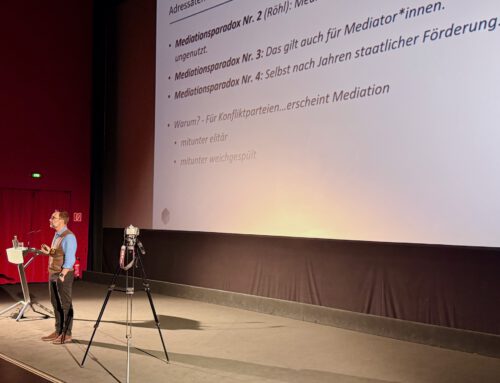Resolve conflicts with fewer attempts at resolution
What is not needed in escalated conflict relationships at the beginning: ideas for solutions from the parties involved!
A plea
A mediator recently complained again (as she had done very often before in other situations) that her colleague simply did not want to respond to her experience-based and legally verifiable understanding of the law and continued to claim that it was in the law without being able to show it. He simply did not accept the provable correctness, which is why she subsequently presented further evidence that he was wrong. There was noise, there was shouting, there was silence. According to the mediator, they were now in conflict.
In the following, I would like to explain my view of conflicts and conflict resolution attempts based on this observation and the mediator's assessment:
Here we go’s:
When people, whether conflict participants or observers, see a conflict event, they label this event as a conflict. This is understandable, but in fact wrong. What they hear and see, and perhaps also experience violently, is not the conflict, but the attempts to end the conflict: From the tense discordant tones in the communication to acts of violence,…all this conflict communication shows and indicates that there is a conflict; however, they are not it, but the attempts to deal with the conflict („successfully“).
This usually has consequences, but does not relieve tension. The efforts of those involved to reduce the conflict tension against the resistance of others escalate the communication and relationship, even if the whole endeavour is based on completely different intentions. That is the tragic aspect of conflicts.
These efforts to assert oneself, the fights, even the shouting and violence, but also the clever, well thought-out arguments are ultimately (testing) efforts to end the tense conflict situations; to bring about the resolution of the conflict. BUT THESE ATTEMPTS ARE NOT THE CONFLICT, BUT ATTEMPTS TO DEAL WITH AND RESOLVE THE CONFLICT.
I can’t define it, but I know when I see it.*
Letting this thought sink in changes your view of conflicts. Because then there's not much left for conflict.
Shouting at people in a discussion is an attempt to end it; often not at all convincing, but nevertheless intentional. The clever, well thought-out, scientifically supported argument…an attempt to end the perceived, sometimes merely fantasised, tension.
However, the conflict can only be de-escalated if the discussion partner accepts these methodological attempts(!). Science is not convincing per se, but only if the parties involved accept this method. The same applies to law as a decision-making method. Only if both sides accept this method (with the communicative consequences that if one is right, the other is wrong) can it have a conflict-deciding effect.
What third parties often see and have to disapprove of are – subjective – attempts at a solution and – objective – escalation drivers! Intention and effect fall apart. A certain consequence in conflict relationships.
The way to hell is paved with good intentions.
That's why mediation initially means above all: fewer ideas for solutions, please!
And that is a concrete suggestion, a piece of advice – and often also an announcement to define what should not be talked about now, at least not at the beginning, because it disrupts the conflict resolution, has an escalating effect – despite all good intentions to end it.
This is why it is important in mediation to first stop trying to find a solution!
Less solution pleaseIt's hard enough as it is.
But what solves conflicts if they are not solutions? Generally speaking, it is a dialogue-based discussion process itself that can be built up with each other and allows the annoying tensions to be released. It is the deceleration of the discussions, the assurance of understanding on the part of the discussants and the calming effects of inquiring and inquiring dialogue. And this is not only the realisation of harmonious humanistic thinking, but also the realisation of cool, sober systems theory.
Consensus is overestimated and the communication process underestimated. (Luhmann)
Conflicts are situations of tension between people that are rarely resolved by clever ideas for solutions to the issues in dispute alone, but are first resolved by strengthening the Confidence and the Confidence The parties must realise that the tension was created together and can be eliminated together. This is initially achieved through a strategically orientated Contact design. In mediation, the first two or three phases are about slowing down, understanding (not agreement!) and calming down. If this is successful, all the ideas for solutions are in demand again and have a chance of being accepted.
And this also explains why it is sometimes better to separate for good, terminate the employment relationship, end the cohabitation and reorientate oneself. The calm view of the tense life or work relationship inevitably shows that there is no confidence in a mutually satisfactory future. Then it is better and appropriate to end the mediation together with a decision to separate. This also makes things easier.
For the mediator I mentioned at the beginning, it was not clear why the law and the laws should suddenly no longer apply, as she had initially understood. This is typical of a situation that is fixated on the law, as the law and the laws seem to justify the situation. It is permissible to refer to this – especially in a conflict, because the law is right. But to whom it gives right here, that is exactly what was in dispute. And of course you can argue about it and that's fine in principle. But if you don't want this dispute, but rather understanding and sympathy for your own point of view, then the constant assertion that you are right is contradictory. But that leads to another topic of conflict management.
*Supreme Court Justice Potter Stewart on obscenity/pornography, 1964.




Leave A Comment